Philippe Levy
-
- Brasa: FPSO Modules a Specialty Maritime Reporter, Aug 2013 #38
There has been a significant increase in shipyard construction in Brazil in yards large and small alike. Maritime Reporter’s Contributing Editor in Brazil visited Brasa Shipyard in Rio de Janeiro and spoke to Philippe Levy, Country Manager for SBM Offshore, who is one of the yard directors. Brasa Shipyard is building FPSO deck modules for integration onto FPSO hulls.
“Brasa shipyard was created by Synergy and SBM in order to simplify FPSO module integration for FPSOs leased to Petrobras for pre-salt oil production,” said Philippe Levy, Country Manager for SBM. “A holding company named SNV was created, with its assets being the shipyard and the crane barge, with equal shares belonging to Synergy and SBM Offshore.”
Since Brasa shipyard is located in the city of Niterói, across Guanabara Bay from the city of Rio de Janeiro, SNV managed to resolve three major bottlenecks at the same location. “These bottlenecks are, the shipyard construction site, a heavy lift crane barge and an integration quayside, therefore allowing us to streamline production, while at the same time eliminating the problem of finding a qualified workforce, by being located within a major city,” said Levy. The new company also has a project office in downtown Rio de Janeiro.
Brasa shipyard can be seen on the right side of the Rio-Niterói bridge, just before arriving at the bridge toll booths. The main construction area and office building are located right next to the bridge and across the channel from the integration quay. While walking through the construction area, which has been fabricating 10 deck modules for the Cidade de Ilhabela FPSO, it became obvious that there was a large amount of detailed work going into each module’s construction, which demands highly specialized labor and stringent quality control. The shipyard is equipped with six mobile cranes (60-130 ton) and two munck trucks (10 ton), two tower cranes (5 ton) and six forklifts (2.5/7/15 ton), one truck with flat trailer, high standard welding equipment and extensive scaffolding equipment.
“SBM has a long track record in Brazil with a long and varied list of successful projects including loading and offloading terminals, turret mooring systems, and turnkey FPSO units. Over the last 15 years SBM Offshore has operated eight FPSOs in Brazil,” said Levy. Until 2008, SBM operations in Brazil comprised two shore bases in Macaé and Vitória, from which seven FPSO units were successfully operated. In 2008 a new design office was opened in Rio de Janeiro.
“Brasa shipyard commenced operation in the second quarter of 2012 with the fabrication of the topsides modules for the FPSO Cidade de Ilhabela, with around 1,600 people directly and indirectly involved in the execution of the project. When completed the modules will be lifted from the yard by the crane barge and transported across the channel to the integration quay and mounted in a specific part of the FPSO deck” said Levy. Cidade de Ilhabela will have a processing capacity of around 150,000 bpd.
In March 2013 Petrobras confirmed a $3.5B fast-track order to SBM. This was for two more FPSOs of the same scale as FPSO Cidade de Ilhabela. The units, known as Cidade de Maricá and Cidade de Saquarema are destined for the deepwater Lula Alto and Lula Central pre-salt fields and will be built at a faster pace than the Cidade de Ilhabela FPSO, in order to keep up with Petrobras’ production plans for its pre-salt plays. “Cidade de Paraty and Cidade de Ilhabela represent the successful launch of our new Generation 3 FPSOs, building on our trusted performance and unrivalled uptime,” said Bruno Chabas, CEO of SBM Offshore.
This decrease in construction time will be possible partially due to the fact that the new builds will be “clones” of the Cidade de Ilhabela FPSO, fabrication and integration of the modules is expected to develop at a accelerated pace now that Brasa Shipyard has a trained workforce with experience in fabricating FPSO modules, along with experience in module integration. “We are delighted to have been selected by Petrobras for this significant project and look forward to starting work on the FPSOs, which are amongst the largest ever built by SBM Offshore. Jointly, the two FPSO’s represent the biggest contract ever awarded to us, underlining our unparalleled expertise and leading position in the market for large-scale tanker conversions to FPSOs,” said Chabas.
The orders for these two units are the largest ever received by SBM Offshore and will keep Brasa shipyard busy until deliveries are made at the end of 2015 and early 2016. The FPSOs will be deployed at the Lula fields in the pre-salt, around 300 km offshore Rio de Janeiro. SBM Offshore will convert two double hull sister vessels into FPSOs in China, after these are integrated at the Brasa Shipyard in Rio, they will be moored in approximately 2,300m water depth, each will have a storage capacity of 1.6 million bbls each.
The topside facilities of each FPSO come in at around 22,000 tons, and will be able to produce 150,000 bpd of well fluids and have associated gas treatment capacity of 6,000,000 Sm3/d. The water injection capacity of the FPSOs will be 200,000 bpd each. The BM-S-11 block, where they will be producing, is under concession to a consortium comprised of Petrobras (65%), BG E&P Brasil (25%), and Petrogal Brasil (10%) for 20 years and will be operated by SBM. The FPSOs will be owned and operated by a joint venture company owned by SBM Offshore, Mitsubishi Corporation, Nippon Yusen Kabushiki Kaisha, with other partners including Queiroz Galvão Óleo e Gás S.A.(QGOG), with SBM Offshore in charge of the construction. The FPSOs will be built following local content specifications, with substantial parts of the project management, procurement and engineering services carried out in Brazil.
The majority of the topside module fabrication, integration, and commissioning will be performed at Brasa shipyard.
FPSOs with GTL
SBM Offshore has joined forces with CompactGTL, cooperating exclusively on offshore projects, to provide a solution using a pioneering new technology to be used on FPSOs, aiming at increased productivity while leaving the environmentally aggressive practice of gas flaring behind.
The GTL (Gas-to-Liquid) modular solution converts the associated gas into synthetic crude oil (syncrude), which can be blended with the natural crude oil cargo produced on the FPSO. A commercial demonstration facility has been in operation onshore in Brazil for two years for Petrobras.
This optimized FPSO with an integrated GTL plant can be applied to an Extended Well Test (EWT) vessel or service or on a full field development. This is the only onboard no-flare solution currently available on the market for offshore oil production and eliminates the need for costly gas export or re-injection infrastructure. This solution has been “Approved in Principle” by Det Norske Veritas in February 2012.
Some key goals of the GTL concept design are the ability to minimize flaring by adopting CompactGTL technology for conversion of all surplus associated gas (after fuel removal) into Synthetic Crude Oil (syncrude). This technology maximizes the amount of integration between CompactGTL process and the FPSO topsides process, utilities and marine systems for improved operability and Capex / Opex optimization and allows the GTL process to be eventually extended to full field developments. The GTL plant module on an FPSO is ideally suited for remote, deepwater locations, and typically for fields with low gas to oil ratios.(As published in the August 2013 edition of Maritime Reporter & Engineering News - www.marinelink.com)
-
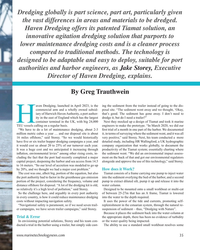 )
November 2023 - Marine Technology Reporter page: 35
)
November 2023 - Marine Technology Reporter page: 35Dredging globally is part science, part art, particularly given the vast differences in areas and materials to be dredged. Haven Dredging offers its patented Tiamat solution, an innovative agitation dredging solution that purports to lower maintenance dredging costs and is a cleaner process compared to
-
 )
November 2023 - Marine Technology Reporter page: 21
)
November 2023 - Marine Technology Reporter page: 21missions. gies Task Force,” said Supreme Allied Commander Transfor- To gain valuable on-site feedback for exercise participants, mation, General Philippe Lavigne. the NATO Maritime Geospatial, Meteorological and Oceano- Concurrent to Dynamic Messenger 2023, Allied Command graphic Centre of Excellence
-
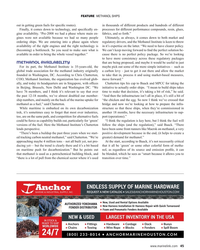 )
November 2022 - Maritime Reporter and Engineering News page: 45
)
November 2022 - Maritime Reporter and Engineering News page: 45FEATURE METHANOL SHIPS out in getting green fuels for speci? c routes). in thousands of different products and hundreds of different Finally, it comes down to technology, and speci? cally en- processes for different performance compounds, resin, glues, gine availability. “Pre-2008 we had a phase where
-
 )
May 2022 - Maritime Reporter and Engineering News page: 18
)
May 2022 - Maritime Reporter and Engineering News page: 18Legal Beat Fuel Tax Repeal Victory in New York State he New York State Petroleum Business Tax (PBT), to local elected of? cials to muster support for legislative change. Article 13-A levies a tax on fuel consumption of In early 2021 it was evident that the present statute did not pro- commercial
-
 )
January 2022 - Maritime Reporter and Engineering News page: 21
)
January 2022 - Maritime Reporter and Engineering News page: 21neta Shipping Index (XSI) for the contract market revealed and port worker shortages will only worsen as the populations a monthly increase of 16.3% month-over-month. This repre- in North America, the UK, and the EU continues to age out. sented the largest month-on-month jump since July and took Consumer
-
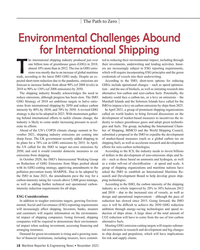 )
November 2021 - Maritime Reporter and Engineering News page: 18
)
November 2021 - Maritime Reporter and Engineering News page: 18The Path to Zero Environmental Challenges Abound for International Shipping he international shipping industry produced just over ted to reducing their environmental impact, including through one billion tons of greenhouse gases (GHG) in 2018, their investments, underwriting and lending activities.
-
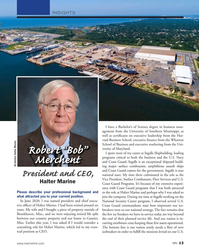 )
October 2020 - Marine News page: 13
)
October 2020 - Marine News page: 13INSIGHTS I have a Bachelor’s of Science degree in business man- agement from the University of Southern Mississippi, as well as certi? cates on executive leadership from the Har- vard Business School, executive ? nance from the Wharton School of Business and executive marketing from the Uni- versity of
-
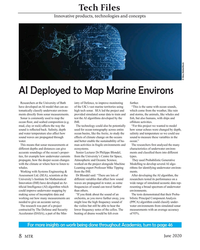 )
June 2020 - Marine Technology Reporter page: 8
)
June 2020 - Marine Technology Reporter page: 8different depths and distances can give ecosystems. characteristics of underwater environ- accurate soundings of the ocean’s proper- Senior Lecturer Dr Philippe Blondel, ments and classifed them into different ties, for example how underwater currents from the University’s Centre for Space, types. propagate
-
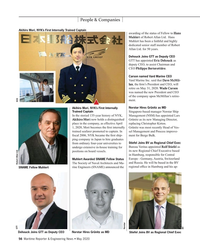 )
May 2020 - Maritime Reporter and Engineering News page: 56
)
May 2020 - Maritime Reporter and Engineering News page: 56member of Robert Allan Ltd. for 50 years. Dehouck Joins GTT as Deputy CEO GTT has appointed eric dehouck as deputy CEO, to assist Chairman and CEO Philippe berterottière. Carson named Vard Marine CEO Vard Marine Inc. said that dave McMil- lan, the frm’s President and CEO, will retire on May 31, 2020
-
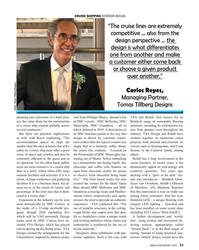 )
March 2020 - Maritime Reporter and Engineering News page: 53
)
March 2020 - Maritime Reporter and Engineering News page: 53over another.” Carlos Reyes, Managing Partner, Tomas Tillberg Designs Photo: Tomas Tillberg Designs planning and realization of a hotel proj- chef Jean-Philippe Maury, aboard a trio YSA and Bolidt, best known for its ect, the value chain for the construction of MSC vessels – MSC Bellisima, MSC Bolideck
-
 )
February 2020 - Maritime Reporter and Engineering News page: 30
)
February 2020 - Maritime Reporter and Engineering News page: 30View from the Top Roger Holm Marine President, Wärtsilä The environmental hurdles in maritime will require a comprehensive, multi-faceted solution set. Roger Holm lends his perspective. ast year saw a quite considerable change in how envi- ronmental aspects are discussed within the maritime community
-
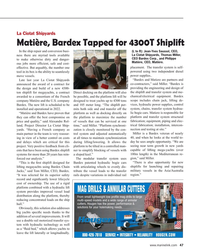 )
January 2020 - Maritime Reporter and Engineering News page: 47
)
January 2020 - Maritime Reporter and Engineering News page: 47and conversion busi- (L to R): Jean-Yves Saussol, CEO, La Ciotat Shipyards, Thomas Miller, ness there are myriad tools available CEO Bardex Corp., and Philippe to make otherwise dirty and danger- Matière, CEO, Matière. ous jobs more ef? cient, safe and cost- effective. But arguably, the number one placement
-
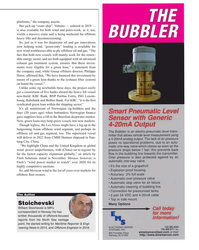 )
January 2020 - Maritime Reporter and Engineering News page: 13
)
January 2020 - Maritime Reporter and Engineering News page: 13gas treatment system, ensures that these invest- ments were eligible for a green loan,” a statement from the company said, while Group offshore director, Philippe Hutse, af? rmed that, “We have ? nanced this investment by means of a green loan thanks to the (exhaust ? lter system) on board the vessel.” Unlike
-
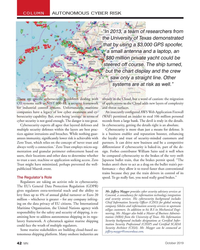 )
October 2019 - Marine News page: 42
)
October 2019 - Marine News page: 42COLUMN AUTONOMOUS CYBER RISK “In 2013, a team of researchers from the University of Texas demonstrated that by using a $3,000 GPS spoofer, a small antenna and a laptop, an $80 million private yacht could be steered off course. The ship turned, but the chart display and the crew saw only a straight
-
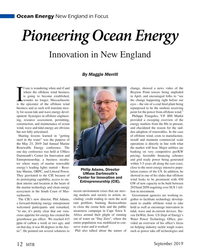 )
September 2019 - Marine Technology Reporter page: 12
)
September 2019 - Marine Technology Reporter page: 12to be the onshore receiving ly for ocean tide and wave energy devel- point for the power from offshore wind.” opment. Synergies in offshore engineer- Philippe Frangules, V.P. IHS Markit ing, resource assessment, permitting, provided a sweeping overview of the construction, and maintenance of ocean energy
-
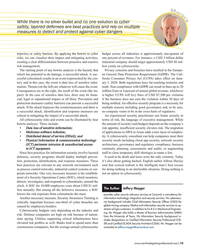 )
Jul/Aug 2019 - Maritime Logistics Professional page: 13
)
Jul/Aug 2019 - Maritime Logistics Professional page: 13M A Y G E R While there is no silver bullet and no one solution to cyber safety, layered defenses are best practices and rely on multiple measures to detect and protect against cyber dangers tripwires or safety barriers. By applying the bowtie to cyber budget across all industries is approximately
-
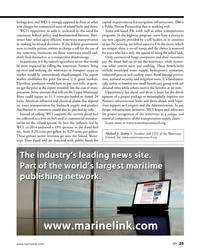 )
February 2019 - Marine News page: 25
)
February 2019 - Marine News page: 25lockage fees, and WCI is strongly opposed to these or other capital improvements for navigation infrastructure. This is new charges for commercial users of inland locks and dams. a Public Private Partnership that is working well. WCI’s opposition to tolls is anchored in the need for Some toll-based
-
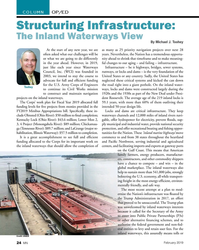 )
February 2019 - Marine News page: 24
)
February 2019 - Marine News page: 24COLUMN OP/ED Structuring Infrastructure: The Inland Waterways View By Michael J. Toohey At the start of any new year, we are as many as 25 priority navigation projects over next 28 often asked what our challenges will be years. Nevertheless, the Nation has a tremendous opportu- or what we are going to
-
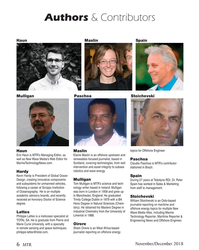 )
November 2018 - Marine Technology Reporter page: 6
)
November 2018 - Marine Technology Reporter page: 6in offshore energy topics for multiple New Industrial Chemistry from the University of Lattes Wave Media titles, including Marine Limerick in 1988. Philippe Lattes is a metocean specialist at Technology Reporter, Maritime Reporter & TOTAL SA. He is graduate from Pierre and Engineering News and Offshore
-
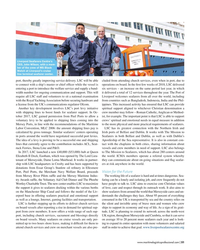 )
Sep/Oct 2018 - Maritime Logistics Professional page: 51
)
Sep/Oct 2018 - Maritime Logistics Professional page: 51Liverpool Seafarers Centre’s CEO, John Wilson, with a mem- ber of the crew of MS Black Watch at Liverpool’s cruise line terminal seafarer center. port, thereby greatly improving service delivery. LSC will be able cluded from attending church services, even when in port, due to to connect with a ship’s
-
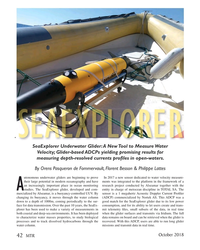 )
October 2018 - Marine Technology Reporter page: 42
)
October 2018 - Marine Technology Reporter page: 42ADCPs yielding promising results for measuring depth-resolved currents pro? les in open-waters. By Orens Pasqueron de Fommervault, Florent Besson & Philippe Lattes utonomous underwater gliders are beginning to prove In 2017 a new sensor dedicated to water velocity measure- their large potential in modern
-
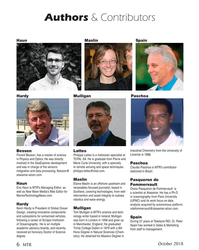 )
October 2018 - Marine Technology Reporter page: 6
)
October 2018 - Marine Technology Reporter page: 6Spain Hardy Mulligan Paschoa Industrial Chemistry from the University of Besson Lattes Limerick in 1988. Florent Besson, has a master of science Philippe Lattes is a metocean specialist at in Physics and Optics. He was directly TOTAL SA. He is graduate from Pierre and involved in the SeaExplorer
-
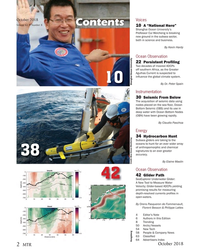 )
October 2018 - Marine Technology Reporter page: 2
)
October 2018 - Marine Technology Reporter page: 2ADCPs yielding promising results for measuring depth-resolved currents pro? les in open-waters. By Orens Pasqueron de Fommervault, Florent Besson & Philippe Lattes 4 Editor’s Note 6 Authors in this Edition 8 Trending 50 Arctic/Vessels 54 New Tech 58 People & Company News 63 Classi? ed 64 Advertisers
-
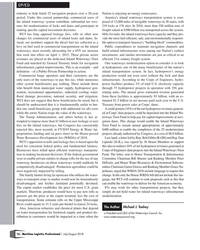 )
Jul/Aug 2018 - Maritime Logistics Professional page: 16
)
Jul/Aug 2018 - Maritime Logistics Professional page: 16OP/ED industry to help ? nish 25 navigation projects over a 20-year Nation is enjoying an energy renaissance. period. Under this current partnership, commercial users of America’s inland waterways transportation system is com- the inland waterway system contribute substantial tax reve- posed of 12
